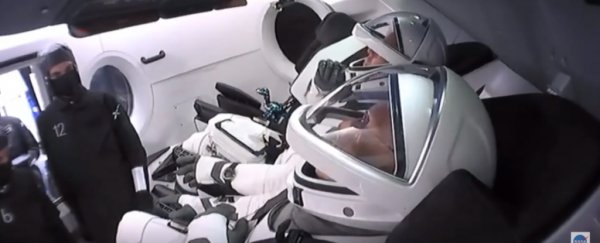SpaceX and NASA are gearing up for a historic mission: On Saturday, they plan to launch humans in a commercial spacecraft for the first time ever and restore the US's ability to send its own astronauts into space.
If clouds don't delay the launch again (as they did on Wednesday), NASA astronauts Bob Behnken and Doug Hurley will board SpaceX's Crew Dragon spaceship, perched atop its Falcon 9 rocket, and hurtle into Earth's orbit. The plan calls for them to reach the International Space Station on Sunday morning.
It's a risky endeavour. NASA hasn't launched its own astronauts since 2011. SpaceX is a young company – it was founded by Elon Musk in 2002 – and its rockets and spaceships have never flown humans.
NASA has told Business Insider that it estimates a 1-in-276 chance that the flight could be fatal and a 1-in-60 chance that a problem would cause the mission to fail but not kill the crew.
The risk to the mission is therefore considered about 4.5 times the risk to the crew. This is in part because of SpaceX's advanced emergency-abort system. Here's how it works.
SpaceX's emergency escape system proved itself in an explosive test
 (SpaceX via Twitter)
(SpaceX via Twitter)
In the event of a rocket failure, the Crew Dragon should detach from the Falcon 9 rocket and fire a set of eight SuperDraco engines to make an escape. That force should jettison the spaceship away from danger, with Behnken and Hurley inside.
At a safe distance from the rocket, the Dragon would then deploy a set of four giant parachutes and drift into the Atlantic Ocean, where rescue teams would pick up the astronauts.
In January, SpaceX tested that system by launching a Crew Dragon capsule on top of a Falcon 9 rocket with no people inside. The company then cut the rocket's engines while it was travelling at around twice the speed of sound, just 84 seconds into the flight.
At that moment, the Crew Dragon detached, fired its thrusters, and sped away from impending doom. The animation below shows the escape system in action during the test.
 (Dave Mosher/Business Insider)
(Dave Mosher/Business Insider)
Shortly afterwards, the rocket succumbed to extreme drag, broke up, and exploded into a fireball. The Crew Dragon landed in the ocean under the sails of its parachutes about 9 minutes after launch.
"It went as well as one could possibly expect," Musk said during a televised NASA press briefing shortly after that abort test. "I'm super fired up. This is great. It's really great. We're looking forward to the next step."
Behnken and Hurley, for their part, have accepted the risk calculated by NASA and SpaceX.
"I think we're really comfortable with it," Behnken told Business Insider earlier this month.
SpaceX has launched its latest Falcon 9 rocket dozens of times. The company has also completed a full (uncrewed) test flight of its new Crew Dragon vehicle and about 20 flights of its Cargo Dragon spaceship.
"Its evolution has become more and more safe as it's been operated, and that's something that we really do appreciate," Behnken said.
This article was originally published by Business Insider.
More from Business Insider:
